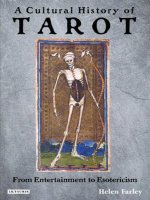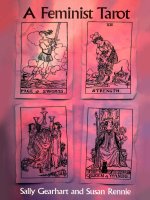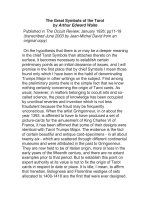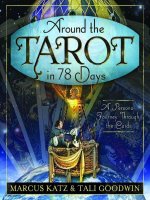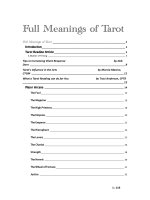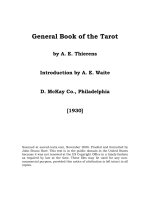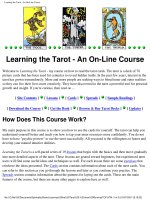Hướng dẫn bói bài Tarot A feminist tarot
Bạn đang xem bản rút gọn của tài liệu. Xem và tải ngay bản đầy đủ của tài liệu tại đây (3.18 MB, 200 trang )
A Feminist Tarot
i
ii
A
Feminist
Tarot
by Sally Gearhart
and Susan Rennie
Self-Published in E-book form by
Sally Gearhart
Willits, California
iii
Paperback, Copyright © 1987, 1997 by Sally Gearhart and Susan Rennie.
E-Book, Copyright © 2008 by Sally Gearhart. All Rights Reserved.
Book layout by Jerri-Jo Idarius
Illustrations from the Rider-Waite Tarot Deck®, known also as the Rider
Tarot and the Waite Tarot, reproduced by permission of U.S. Games
Systems, Inc., Stamford, Connecticut 06902, USA. Copyright © 1971
by U.S. Games Systems, Inc. Further reproduction prohibited. The RiderWaite Tarot Deck is a registered trademark of U.S. Games Systems, Inc.
Paperback first published by Persephone Press: 1976
Fifth edition (First Alyson Publications edition): 1981
E-book Self-Published by Sally Gearhart: 2008
iv
CONTENTS
Preface . . . . . . . . . . . . . . . . . . . . . . . . . . . . . . . . . . . . . . . . . . . . . . . vi
Introduction . . . . . . . . . . . . . . . . . . . . . . . . . . . . . . . . . . . . . . . . . viii
Using the Tarot . . . . . . . . . . . . . . . . . . . . . . . . . . . . . . . . . . . . . . . . . 3
The Major Arcana
The Fool . . . . . . . . . . . . . . . . . . . . . . . . . . . . . . . . . . . . . . . . . . . . . 10
The Magician . . . . . . . . . . . . . . . . . . . . . . . . . . . . . . . . . . . . . . . . . .12
The High Priestess . . . . . . . . . . . . . . . . . . . . . . . . . . . . . . . . . . . . . . 14
The Empress . . . . . . . . . . . . . . . . . . . . . . . . . . . . . . . . . . . . . . . . . . 16
The Emperor . . . . . . . . . . . . . . . . . . . . . . . . . . . . . . . . . . . . . . . . . . 18
The Hierophant . . . . . . . . . . . . . . . . . . . . . . . . . . . . . . . . . . . . . . . 20
The Lovers . . . . . . . . . . . . . . . . . . . . . . . . . . . . . . . . . . . . . . . . . . . 22
The Chariot . . . . . . . . . . . . . . . . . . . . . . . . . . . . . . . . . . . . . . . . . . 24
Strength . . . . . . . . . . . . . . . . . . . . . . . . . . . . . . . . . . . . . . . . . . . . . .26
The Hermit . . . . . . . . . . . . . . . . . . . . . . . . . . . . . . . . . . . . . . . . . . .28
The Wheel of Fortune . . . . . . . . . . . . . . . . . . . . . . . . . . . . . . . . . . .30
Justice . . . . . . . . . . . . . . . . . . . . . . . . . . . . . . . . . . . . . . . . . . . . . . 32
The Hanged Man . . . . . . . . . . . . . . . . . . . . . . . . . . . . . . . . . . . . . . 34
Death . . . . . . . . . . . . . . . . . . . . . . . . . . . . . . . . . . . . . . . . . . . . . . .36
Temperance . . . . . . . . . . . . . . . . . . . . . . . . . . . . . . . . . . . . . . . . . . . 38
The Devil . . . . . . . . . . . . . . . . . . . . . . . . . . . . . . . . . . . . . . . . . . . .40
The Tower . . . . . . . . . . . . . . . . . . . . . . . . . . . . . . . . . . . . . . . . . . . .42
The Star . . . . . . . . . . . . . . . . . . . . . . . . . . . . . . . . . . . . . . . . . . . . . .44
The Moon . . . . . . . . . . . . . . . . . . . . . . . . . . . . . . . . . . . . . . . . . . . .46
The Sun . . . . . . . . . . . . . . . . . . . . . . . . . . . . . . . . . . . . . . . . . . . . . 48
Judgement . . . . . . . . . . . . . . . . . . . . . . . . . . . . . . . . . . . . . . . . . . . .50
The World . . . . . . . . . . . . . . . . . . . . . . . . . . . . . . . . . . . . . . . . . . . .52
The Minor Arcana
The Suit of Pentacles . . . . . . . . . . . . . . . . . . . . . . . . . . . . . . . . . . . . 57
The Suit of Swords . . . . . . . . . . . . . . . . . . . . . . . . . . . . . . . . . . . . . .87
The Suit of Cups . . . . . . . . . . . . . . . . . . . . . . . . . . . . . . . . . . . . . . 117
The Suit of Wands . . . . . . . . . . . . . . . . . . . . . . . . . . . . . . . . . . . . . 147
Bibliography . . . . . . . . . . . . . . . . . . . . . . . . . . . . . . . . . . . . . . . . . 177
v
PREFACE
S
ince the last printing of A Feminist Tarot, we have been heartened by the increase in interest in the tarot in general and by the
enthusiastic response to this book in particular. That response
has come from men as well as from women, whose critical remarks
have been helpful in our revision of the book for this new edition.
Particularly we would like to acknowledge Jane Gurko, without whose
critical faculties the revision would never have been accomplished.
We are grateful too for the help given us by Gloria Anzaldua, Kirsten
Grimstad, Christine Menefee, Louisiana Sissies in Struggle, Alyse B.
Tartell, and Joyce and other Sisters of Aradia.
The text of the book has been somewhat altered to include our own
changing perspectives and our responses to constructive criticism. We
hope that the new introduction and bibliography will increase the
book’s usefulness. We still see A Feminist Tarot as only a beginning in
women’s recovery of the tarot from traditional masculinist bias. And
we still acknowledge that the views expressed here have their own
limitations. Our hope is that the work we have done will aid others
in uncovering more of the meanings inherent in the cards so that the
tarot becomes truly an instrument for women’s self-discovery and selfexploration.
Since the last printing of this book, its original publisher, Persephone Press, has been forced to cease. Both of us, Susan and Sally, want
to express our gratitude to the women of Persephone not only for their
commitment to women’s culture, but also for the fairness, straightforwardness, and willingness to struggle that characterized our
association with them. From its inception in 1976, Persephone Press
gave the women’s movement access to an astonishing amount of lesbianfeminist and feminist literature; some of their publications have become
classics. So even while we mourn the loss of Persephone, we cherish
its gifts and acknowledge its vision of lesbian publishing. The women’s
movement and the lesbian/gay movement share a fundamental need
for publishing houses that can risk the publication of books that
represent us. One such publishing house has been A Feminist Tarot’s
present publisher, Alyson Publications. Its founder, Sasha Alyson, took
over a number of Persephone’s titles and has seen to it that they remain
vi
available to the movement and to the world at large. Our association
with Sasha and the staff of Alyson Publications has been from the outset
a pleasure and a benefit. We’re glad to be a part of that enterprise and its
commitment to the spread of lesbian, feminist, and gay literature.
Sally M. Gearhart
San Francisco
Susan Rennie
Los Angeles
vii
INTRODUCTION
A
fter the publication of A Feminist Tarot in 1976, women
frequently questioned us about our use of a traditional deck.
Why hadn’t we used a new feminist-envisioned tarot to
accompany our feminist interpretations? The current renaissance of
interest in the tarot has resulted in at least a dozen newly conceived
decks whose images are considerably changed from the traditional
images of the tarot trumps and the minor arcana, familiar to us since
Waite published his deck in 1911. These have included at least one “woman’s”
deck in which the images have been drastically altered to eliminate what the
author sees as patriarchal bias. We applaud these new developments,
particularly as they contribute to our women’s culture, and we hope for
their continued success.
But a large part of the answer to the original question—our choice
of the Waite-Smith deck—has to do with our understanding of what the
tarot is, our beliefs about its historical lineage, and our conception of its
use and function. We feel that the power of the tarot derives from an
ancient and complex symbology that represents all aspects, forces, stages,
and configurations in our psychic lives - a totality of human experience.
The traditional tarot, with all its richness and mystery, can be a woman’s
tarot. That, essentially, is what we have attempted to show: the reappropriation of meaning within the original matrix. The “old” cards, seen from
an altered angle of vision, can be used as a tool for self-analysis to explore
our inner regions, to give ear to our inner voices; they still activate the
potent insights and connections that the tarot was always meant to evoke.
In fact if we look at its ancestry, we will see that the tarot is a particularly
appropriate vehicle for women with feminist consciousness. At its very
core it is synchronous with that vision which honors the female principle
as a creative and dynamic force in the universe.
There are a number of fanciful myths about the origins of the tarot.
One of the most popular stories is that it was introduced into western Europe by the Gypsies; another, that it was produced at a gathering of sages
and wise men at Fez. The Gypsy theory speculates that these itinerant
people made their way into Europe over the course of several centuries,
carrying with them the wisdom of ancient Egypt whence they came—
hence “Gypsy.” The wisdom was encoded in the tarot, which they used in
viii
Introduction
a debased form as a method of fortune-telling. There is even a “tarot” deck,
the Grand Etteila of the Gypsies, that is based on this myth, but which
resembles traditional decks in little else than name. The wise-men
story explains the tarot as a book of symbols representing the synthesized
esoteric knowledge of the ancient, pre-Christian world put together at a
convention of sages and adepts sometime after the burning of the great
library at Alexandria. Their purpose was to keep that knowledge alive in
the face of an advancing, militant, monolithic Christian patriarchy.
These stories may contain a kernel of truth, as we shall see, but there
is simply no evidence to substantiate their claims. The Gypsies in fact
originated not from Egypt but from India and they reached western
Europe about 100 years after the tarot had appeared in France and Italy.
The only factual evidence we have about the origins of the tarot are
seventeen exquisitely painted cards now in the Bibliotheque Nationale in
Paris. We know that these cards can be dated to 1392 because of an entry
in a ledger by a court treasurer to Charles VI of France noting that a
particular amount of money had been paid to the artist Jacquemin
Gringoneur for three packs of these cards. This is the first documented
appearance of the tarot. About thirty years after Gringoneur was paid for
his deck Bonifacio Bembo painted a deck for the Duke of Milan. This
Visconti deck (taking the family name of the reigning house of Milan) is
the first full tarot deck of which we have any record. Prior to these dates
there is nothing-no cards, no literary or historical reference anywhere.
Whether Gringoneur and Bembo were the authors of the decks they
painted, whether they copied existing decks or were instructed in what to
paint, we do not know. It is true that the Marseilles deck, first published
in the seventeenth century, is considered by many scholars—based on internal evidence such as costuming and decorative motifs—to date back to
the early fourteenth century, that is, before Gringoneur’s cards. And it is
likely that the lavish cards painted for the French Court were copied from
some existing deck —which, if it were so, would take the earliest tarot to
the early 1300s. Any information we have to indicate an earlier existence
is hypothetical. There are only clues and suggestions, from which all sorts
of theories have been constructed.
All speculations agree on one particular: that the tarot is a book of
knowledge, “an encyclopedia of magical memory images,” as Paul Huson
ix
Introduction
has called it, representing a system of mystical wisdom encoded in the
pictures of the twenty-two trumps and in the numerology of the fifty-six
minor-suit cards. Hypotheses are generally more persuasive when they are
not inconsistent with known evidence, when in fact they are congruent
with the given facts. If we look at the period in which the tarot first
appeared—or first surfaced—there is much to support this notion of its
being a pictorially camouflaged belief system.
The late fourteenth and early fifteenth centuries was a period during
which the Church was truly becoming the Church Militant—flexing its
muscles in the battle to suppress all non-Christian and non-patriarchal
expressions of religion. In particular it attempted to suppress the Old
Religion, the gnostic heresies flourishing in northern Italy and southern
France (the Waldenses, Cathari, Albigenses), the Jews, and social dissenters
such as homosexuals. The Church went after these deviant groups with
zeal and determination. Most were systematically, literally, burned out
of Christian Europe. The extirpation of the major Cathar heresy in the
Languedoc—a region of southern France where in large areas it was the
dominant religion—was carried out through a series of crusades mounted
by the French monarchy (wielding the sword for the Church) with such a
degree of thoroughness that there is today no evidence of this large, well
organized, and sophisticated sect except for the Church’s own records of
their persecution and destruction. Similarly we have no evidence except what has survived in Church documents of the beliefs, rituals,
and practices of the Old Religion.
It makes sense that faced with this kind of onslaught, the keepers of
non-Christian, esoteric, and perhaps orally-based doctrine would look for
some way to secure its preservation and survival—intact from the Church.
What better way than in picture cards, used in a gambling game (tarocchi
was the Italian game for which the Visconti deck was designed) or that
other timeless passion which people everywhere seem to share—fortunetelling? And what better way than to have the picture cards represent
familiar cultural figures (the Fool, the Pope, the Emperor, the Hermit)
and homilies (Temperance, Justice, Judgement)? And jokes—because the
idea of a female pope was certainly a joke on the Church. True, one card
failed to fit so easily into medieval popular culture—the mysterious and
provocative Hanged Man. But even this card could be passed off as a
x
Introduction
criminal on the gallows, a familiar enough part of medieval scenery
(although how often appearing upside down is another matter).
Using pictures as a storage device, a highly elaborate filing-and retrieval
system, was a well-developed medieval technique. In fact commentators
occasionally point to the medieval ars memorativa or mnemonics by
which pictorial images arranged in a special order could be used to release
whole categories of mental associations; they see mnemonics as the ideal
vehicle for encoding an elaborate and complex cosmological/metaphysical oral tradition. Pictorial encoding was not only safer; in an age when
writing was a restricted art, it made messages more accessible. Of course
Christian vigilantes eventually tumbled to what they suspected were
the inherent dangers of these innocent-looking game cards. As early as
the 1420s preachers were inveighing against card gaming and fortunetelling as an invention of Satan, and to this day the tarot is known in
some parts of Europe as “the Devil’s picture book.” But luckily, by this
time, the cards were too widespread to be suppressed.
If one trips away the names—Pope, Papess, Emperor, Hermit,
juggler—what is left are powerful images which are anything but Christian
in origin, anything but patriarchal in inference, and certainly of much
greater antiquity than the superficial medieval stereotypes would suggest.
It is true that the cards show the influence of the medieval culture in
which they were presumably first translated from oral wisdom to painted
pictures, but we should remember that even so it is through the mesh of
dissident and defiant medieval Europe that they were filtered.
The images of the tarot, their symbolism, can be traced back to the
gnostic cults that thrived in the early Christian era, cults which in turn
blended elements of Greek philosophy and Jewish mysticism with Indian
and Persian metaphysical teachings, Egyptian mystery rites with some
seasoning of Christian doctrine. Most occult historians locate the occult
arts of the West - including alchemy and astrology, in addition to the
tarot—in this early melange of Gnosticism. Gnostic is a Greek derivation
for “someone who knows,” a wise man or woman; “wicce,” the Anglo-Saxon
derivation of witch, means the craft of the wise woman or man. In both
instances the strong implication is that the wisdom is part of an esoteric or
hidden tradition.
We know, even if from unfriendly sources, that dissident cults were
xi
Introduction
activated again in the twelfth and thirteenth centuries in the heretical
sects of the regions in Europe, where the tarot made its first known appearance. We also know that at this time Jews, particularly Spanish Jews,
were moving to the more hospitable climate of the Languedoc because
of mounting church persecution. So hospitable to the Jews were the Cathar
dissidents that one of the principal indictments of their heresy, formally
listed by the Church Inquisition, was that Cathar communities extended
full citizenship to Jews and allowed their participation in civic affairs.
It is documented by a wrathful Church that in times of trouble
Cathari hid Jews and Jews hid Cathari, depending on who was taking the
heat. More interestingly, certain Jewish mystics, who were looked at
askance by their own orthodox community, found refuge among the
Cathari, whose effulgent and efflorescing culture represented an openness
and receptivity to new ideas, which was extraordinary in the history of
Europe. This welcome Jewish presence among the French heretics could
provide one of the keys to the origin of the tarot—again an entirely
speculative connection, but enormously suggestive, as we shall see.
So far as we know, the tarot languished until the eighteenth century,
being used only as a fortune-telling tool by the Gypsies of Spain and
southern France as well as by the strege or wise women of Italy. In the
eighteenth century, coincident with a resurgence of interest in the occult, the
tarot was “rediscovered” by scholars, Masons, and Rosicrucians who realized that the cards amounted to much more than fortune-telling devices. In the nineteenth century Eliphas Levi, a French Rosicrucian and
occult scholar, uncovered the provocative correspondences between the
tarot and the Kabbalah. This relationship is an important clue in understanding the tarot as a very rich and meaningful system of cosmology.
Indeed, it is a connection which identifies the tarot as the repository
of ancient wisdom hinted at in the myths of its origin: a symbolic system of objective knowledge that provides answers to some of
our oldest, perennial questions about the nature of the universe. For the
Kabbalah is an underground body of Jewish mystical knowledge that is
quite basic to all western occultism. It is nothing less than the original
(and suppressed) cosmology, which enthroned patriarchy at the expense
of a more female-oriented belief system.
The Hebrew alphabet contains twenty-two letters, the same number,
xii
Introduction
of course, as the tarot trumps. Kabbalists attribute special spiritual power
and significance to each letter—in fact, arranged on the connecting
paths of a glyph known as the Tree of Life, they provide an understanding
of the cosmos. Thus, positing a correspondence between these letters and
the twenty-two major arcana gives the cards an immediate Kabbalistic
interpretation. The Kabbalah is also concerned with the four letters
of God’s name, which represent, among other things, the four worlds
of creation, the four stages of existence, and the four basic elements: fire,
water, air, earth. There are four court cards in each of the four tarot suits,
and each suit is identified with one of the four elements: pentacles/earth,
wands/fire, swords/air, cups/water. Then the Kabbalah works with the
number ten - the ten sephiroth or emanations (connected by the twentytwo paths). The four tarot suits consist of cards numbered one through ten.
Further, the Zohar—a collection of Kabbalistic wisdom that states among
other things that male and female exist in all created things—was first
published in the fourteenth century, roughly the same time that the
tarot appeared. Even though it is true that in the published writings
of the Kabbalah there is no mention of the tarot, still the correlations and
connections seem to go on and on.
The ways in which the tarot can be used as a meditational and
mystical system in conjunction with the Kabbalistic Tree of Life are
far too complex to go into here. However, we do hope to expand the next
edition of A Feminist Tarot to include an exploration of the Tree of Life
from a feminist perspective because, like so much else, the Kabbalah has
presumably suffered alterations, distortions, and accretions in its passage
through masculinist culture. What is important for us here is that the
Kabbalah is a system of wisdom about the universe and our place in
it, which acknowledges the dynamic force of the female principle. It
correlates with the other non-patriarchal beliefs that also appear to have
contributed to the symbolism of the tarot.
We speculate that the tarot was the product of a synthesis—a
synergistic association—between the bearers of an ancient, pre-patriarchal tradition and the practitioners of an “heretical” belief system that
resonated with the ancient beliefs and which were anathema to the
Christian Church. Both the ancient and the “heretical” strands were
sharply different from the anti-nature, anti-woman dogmatism of the
xiii
Introduction
Christian-centered warp of western culture. In true Gnostic tradition,
for example, Cathar women served equally with men in what
were sacerdotal roles - one of their most horrendous heresies. We also
know that Cathari in the ministry were vegetarians, sworn to observe the
sanctity of all living creatures. We don’t know what their esoteric beliefs
were, but the Church considered them worthy of 100 years’ holy war;
and if the Cathari were consistent with what we know of other strands
of Gnosticism, they were not patriarchal. Future scholarship will probably
unveil other striking consistencies between ancient pre-patriarchal traditions and the non-patriarchal practices of medieval heretics.
What is also important about the putative link between the Kabbalah
and the tarot is the very clear suggestion that the images are not random,
parochial symbols, but an ordered system of ancient archetypes. First and
foremost this is the essence of the cards: they are archetypes of the
unconscious, seed ideas which evoke specific intellectual and emotional
responses. Their principal function is to trigger hidden springs of knowledge, allowing us to make conscious connections. The way in which
these particular images enliven or potentiate our imagination, yielding
mysterious benefits in divination far greater than should be expected, has
been well-known to occultists of the past as well as to those of the present. To discard the images, or to change them beyond recognition, would
risk losing their particular power, that of bringing into consciousness the
connections which are so revealing and enlightening.
Our speculations bring us to the question of divination. Why use
the tarot? And why use the Waite-Smith deck? As we wrote in the
introduction to the previous edition of A Feminist Tarot, “The querent
(the one asking the question) and/or the reader (if the reader differs from
the querent) could as easily read about the question from a marble-top
table, tea leaves, or raindrops on a windowpane—from any configuration or set of symbols conducive to focusing on the vibrations
surrounding the question.” Theoretically, focusing attention on what
would otherwise be a random distribution of variables stimulates the
unconscious in some unknown way, and in some equally unknown way the
position of the variables being considered is presumably affected. Any
system will yield some sort of information; the value of that information, though, depends on the intrinsic wisdom of that system. Each
xiv
Introduction
tarot picture is by itself a rich and deeply evocative set of symbols which
relates to the core experiences of the human condition and the human
psyche; in the patterns that the tarot cards form in any chosen spread
- with whatever meanings assigned to the various positions - they can yield
rich and complex insights in understanding ourselves, because unlike tea
leaves or raindrops they were designed to yield these patterns. That’s why
we think it is vital to use a deck that maintains the essential integrity of the
original images as does, for example, the Waite-Smith deck.
There are numerous tarot decks, both historical and contemporary,
which exhibit striking differences in style and form but which maintain
the basic integrity of the images. There are, for example, widely differing
representations of Death, but the concept of Death is there unmistakably.
In more recent times, many of the decks that have been redesigned
elaborate the cards’ symbolism—reflecting the extensive information
about the tarot excavated by nineteenth- century occult scholars. The
changes are an attempt not so much to express the personal world view
of the authors (as do decks such as the New Tarot, the Witches’ Tarot,
the Aquarian Tarot), as to “get it right.” The three best-known contemporary decks—the Waite-Smith, Paul Foster Case’s BOTA, and Crowley’s
Thoth—are all examples of the attempt to construct a tarot which is the
“true,” the “rectified,” or the “restored” deck (words used by both Waite and
Crowley). (Incidentally, all three of these decks were painted by women:
Pamela Coleman-Smith, Jessie Burns Parke, and Frieda Harris, respectively.
How much the artists contributed to the conceptualization we don’t know.)
The significance of these three decks (as well as the recently published
but aesthetically disappointing Regardie-Wang deck) is the membership
of Waite, Case, and Crowley in the secret hermetic Order of the Golden
Dawn. This was an occult society founded in England in 1888 dedicated
to the continuation of ancient esoteric tradition through the study and
practice of the Western occult arts. For our purposes, it is very important
to note that women were not only admitted and participated in the society on
an equal basis with men, but also that the beliefs and rituals of the Golden
Dawn were Goddess-centered.
The Golden Dawn lasted a scant fifteen years, but its influence,
especially on the tarot, has been enormous. Virtually every major tarot
deck of the twentieth century is derived from the deck used by
xv
Introduction
the members of the Order. That deck, in turn, was the product of deep
research and study by one of its founders, MacGregor Mathers, and
—a fact rarely mentioned in works on the history of the tarot—his wife,
Moina, who frequently conducted the Order’s ceremonies in the role of
High Priestess. The deck incorporates a virtual archaeology of the symbolism
of the tarot, including the numerological and astrological significances of
the cards, their Kabbalistic correspondences, the importance of colors,
and even such details as the relevance of which way the figures in the cards
face. The Golden Dawn claimed to be the inheritor of ancient keys to
psychic power handed down through the centuries by means of a hidden
oral tradition. It was not only the intensive research which had gone into
the history of the tarot that gave the Golden Dawn deck its special
puissance, members claimed, but also their access to this secret oral
tradition.
The society’s research and its claim to special information may explain
the particularly compelling quality of the decks published by its
members, most specifically the Waite-Smith, the Case, and the Crowley
decks. While we cannot say that there is any such thing as a “true” deck, of
the three the Waite-Smith deck seems the most symbolically powerful and
useful to us. It is more widely available and better known than Case’s
BOTA, even though there is little difference in detail between the two.
Crowley’s Thoth deck, for all its seductive and stunning beauty, rouses in
us strong reservations of conscience since it was designed by a man who
exhibited a vicious and infamous hatred of women.
However, all existing decks pose very real problems for feminists,
Waite-Smith’s included. Many women do not find offense in the
traditional imagery of the tarot. What has been a sore spot has been the
rampant masculinist bias in the traditional interpretations, the meanings
attributed to the cards—even by sensitive women tarotists such as Eden
Gray. This was the original impulse behind A Feminist Tarot: to develop
the meanings that the cards evoke in a feminist imagination.
But interpretation is not the only problem. Some women have found
offense in what they see as a visual sex-role stereotyping in the pictures
themselves. We have hoped that A Feminist Tarot would challenge this
depiction of women in the cards.
The matter of other caste-marked (meaning those who cannot hide)
xvi
Introduction
groups is different. Pictorially all the decks we know of ignore the physically
disabled and people of color. There are some tired people in the cards,
some blindfolded and even wounded; but there is only one pair of crutches
evident (the five of pentacles), and the parade of fully perceptive, physically
active, able-bodied characters is overwhelming. It is true that blindness,
deafness, and much physical disability are not always apparent and should not
be hauled out for caste-marking even by well-intentioned artists or interpreters. But the question of disability must permeate our awareness and
influence our interpretations wherever possible.
The matter of race in the cards is more obvious. No amount of
argument about the origin of the tarot among dark-skinned people, no
cataloging of the changes the cards have been subjected to by white
European cultures, and no rhapsodizing about the universality of the
concepts represented can minimize the effect of the blond and fair-skinned
personae who dominate the cards’ imagery. We consider this a particularly
limiting characteristic of the Waite-Smith deck. It is true that the tarot, like
other artifacts, rises out of a specific culture; and perhaps we should be
able to transpose into global terms the specifics of that culture—costumes,
properties, settings, and the white skins. But one reason why people of
color may not use the tarot, particularly decks full of human forms, is
precisely because such transformations are not worth the hassle. It is true
that the Crowley deck with its overall bizarre colors and its non-human
symbols in the majority of suit cards may allow for more universal interpretation; it is also true that Case’s BOTA deck comes without color so
that the user can paint the drawings - including skin patches - for most
meaningful interpretation. But even such suggestions seem like sops and
do not adequately address the problem of the predominantly Caucasian
figures suggested in all the decks. We have decided after careful consideration of this issue that the most important factor in dealing with the
problem may simply be our open acknowledgment of the limitations and
our openness to the experience and viewpoint of people of color in the
interpretations of the cards themselves. Even in spite of these limitations,
the Waite-Smith deck still harbors for us a greater richness and power in
its images than other decks. We want to continue its exploration with full
acknowledgment of these questions.
Finally, the matter of caste-marked figures and the need for wide
xvii
boundaries in interpretation bring up an equally significant political matter. How can we use the study of the occult (the I Ching, the tarot, astrology,
the Kabbalah) to encourage dialogue between the “hard-core politicos”
who supposedly scorn such approaches and the so-called “spiritual”
feminists who are accused of retreatism and political irresponsibility?
We both feel that such divisions are more often manufactured among
us than inherent in feminist politics, even though we also acknowledge
that human beings differ in their approaches to reality. We both think of
ourselves as political activists and as spiritually concerned feminists. We
believe that a consideration of both the “material” and the “psychic” is
necessary to the growth of individuals and to the development of feminism as a global force. We hope that “hard-core politicos” will remain
open to the messages that can come from meditation or from sources beyond hectic daily experience; we hope that feminists who learn and grow
from the occult do not let their politics end there but see the necessity for
carrying that creative energy into concrete social action. It seems to us
that, by affirming each other and our differing approaches to reality, we
can only gain in mutual support and political power.
xviii
A Feminist Tarot
1
2
USING THE TAROT
Reading the Cards
Reading the tarot is an attempt to perceive and understand the conscious and unconscious reality surrounding a particular question or circumstance. What is important in a tarot reading is whatever is discovered.
The discovery is limited only by the reader’s openness and sensitivity to
the meaning of the cards. Sensitivity grows with acquaintance with the
deck and practice in exploring relationships of symbols to particular questions.
The reading should be regarded as a meditation. Before beginning the
reader should try to center her energy and quiet down the activity of her
conscious mind. This can usually be achieved by doing a few deep breathing and relaxation exercises. While shuffling and cutting the cards the
reader should try to keep her mind clear but focused on the cards, while
the querent (if she differs from the reader) should concentrate on the question being explored. The reader shuffles the cards and asks the querent to
cut them three times to the left with the left hands. The querent then hands
the cards back to the reader and the layout begins.
Reversed Cards
There are varied opinions on the significance of reversed cards. Some readers contend that the dialectic of both positive and negative is inherent in
every card, and thus do not read a reversed card as any different from an upright card. Others read reversed cards as an unstable quality to be applied
to the upright interpretation. Still others consider the reversed to be very
different from the upright interpretations. We have used a combination
of the latter two approaches; thus readers may either ignore the reversed
interpretations or take into account our suggestions.
3
A Feminist Tarot
The Court Cards
It seems, judging from our own experience and that of women who have
talked with us, that the Court cards present one of the most puzzling and challenging aspects of reading tarot. Most traditional interpreters see the
Court cards as actual men and women connected with the querent and
her question. For example, the King of Wands is a “blond, married man
of authority; a devoted friend”; the Princess or Page of Cups is a “captivating
boy or girl; studious, friendly” (Eden Gray). Others attribute to the Court
cards particular personality attributes and characteristics such as strength
or authority (king of Swords), kindness or generosity (Queen of Wands).
There are other formulas, but somehow they have not worked satisfactorily for us.
About a year after A Feminist Tarot was published, one of us received
in the mail some xeroxed pages entitled The Psychic Tarot by Joanne Kowalski. Included was a short discussion of how to read the cards, as well as a
discussion of their meanings. We were struck by the clarity and sense of
the interpretations, which have provided one of the most helpful sources
shaping our own perceptions. But in particular we were taken by this
woman’s approach to the Court cards. This approach has made a difference in our understanding of these cards in a spread, and we want to share
this information with our readers. (To our knowledge, The Psychic Tarot is
not available in book form.) We thank Joanne for her illuminating contributions. Here is what Ms. Kowalski says about the Court cards:
The king and queen refer to self-security with regard
to the attributes represented by their suits, and the page
(princess) and knight (prince) to the active use of these
attributes. Thus, the kings stand for feelings of security
regarding the self ’s ability to perform the activities represented by the suit and the queen, self-security in receiving
(learning, getting in touch with, etc.) the attributes of the
suit. The knight (prince) is the active doer, the symbolization of actually performing and going out with the qualities
of the suit while the page (princess) is the seeker for new
horizons, the student, the receiver of ideas and feelings.
4
Using the Tarot
Thus, taking Wands as the suit that represents energy and growth,
we would suggest that the King of Wands represents the querent’s security in her own changes and development. The Queen would indicate
the querent’s security in her own potentiality for growth and change, or
her security in her ability to accept the growth and change of others.
The Knight or Prince would show that the querent is actively involved in
change and development, while the Page or Princess would indicate that
the querent is seeking growth and change in the matter being considered
in the reading. And so with the other suits.
Spreads
The most popular spread in use today is the so-called Celtic spread
originally published by Waite in The Pictorial Key to the Tarot (1910).
This spread is supposed to be the most suitable for obtaining an answer
to a definite question.
5
A Feminist Tarot
1. What Covers Her —This card gives the influence that is
affecting the person or matter of inquiry generally, the
atmosphere of it in which the other currents work.
2. What Crosses Her — This shows the nature of the
obstacles in the matter. If it is a favorable card, the
opposing forces will not be serious.
3. What Crowns Her — This represents the querent’s aim
or ideal in the matter, or the best that can be achieved
under the circumstances.
4. What is Beneath Her — This shows the foundation or
the basis of the matter, or the best that can be achieved
under the circumstances.
5. What is Behind Her — This gives the influence that has
passed or is now passing away.
6. What is Before Her — Shows the influence that is
coming into action and will operate in the near future.
7. Herself — The person’s position or attitude toward the
question.
8. Her House — Her environment and the tendencies at
work therein that have an effect on the matter—for
instance, the influence of family or immediate friends.
9. Her Hopes and Fears — This card shows either what
she hopes or fears in the matter.
10. What Will Come — The final result, the culmination
that is brought about by the other cards which have
turned up in divination.
6
